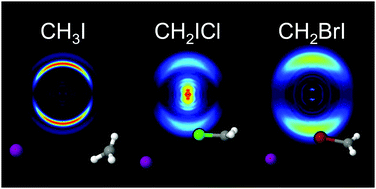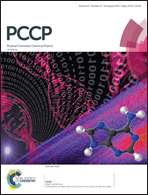Halogen-atom effect on the ultrafast photodissociation dynamics of the dihalomethanes CH2ICl and CH2BrI†
Abstract
A comparative study of the ultrafast photodissociation dynamics of the dihalomethanes CH2ICl and CH2BrI has been carried out at 268 nm, around the maximum of the first absorption band, employing femtosecond velocity map ion imaging in conjunction with high level ab initio electronic structure calculations and full dimension on-the-fly trajectory calculations including surface hopping. Total translational energy distributions and angular distributions of the iodine fragments as well as reaction times for the C–I bond cleavage are presented and discussed along with the computed absorption spectra, potential energy curves and trajectories. The revealed dynamics is mainly governed by absorption to the 5A′ state for CH2BrI while two dissociation pathways, through the 4A′ or 5A′ states, are in competition for CH2lCI. An anchor effect due to the substituent halogen atom (Br or Cl), which implies significant rotational motion of the dissociating molecule, characterizes the photodissociation in both dihalomethanes and leads to a remarkable rotational energy of the radical co-fragment. This energy flux into the internal degrees of freedom of the molecules is the main key factor governing the real time reaction dynamics.



 Please wait while we load your content...
Please wait while we load your content...